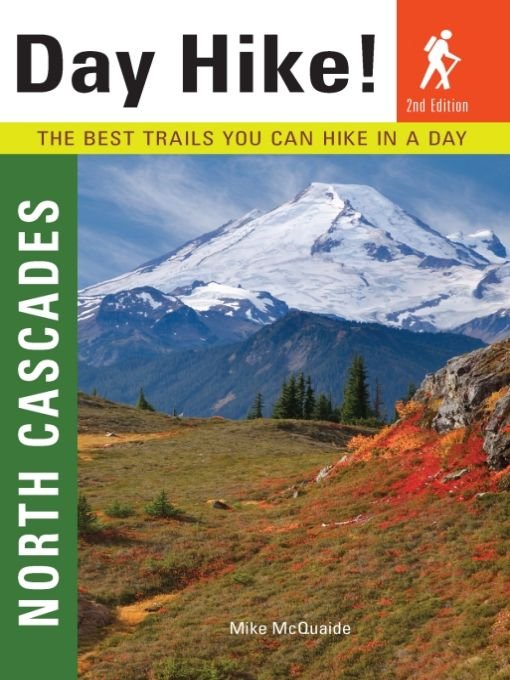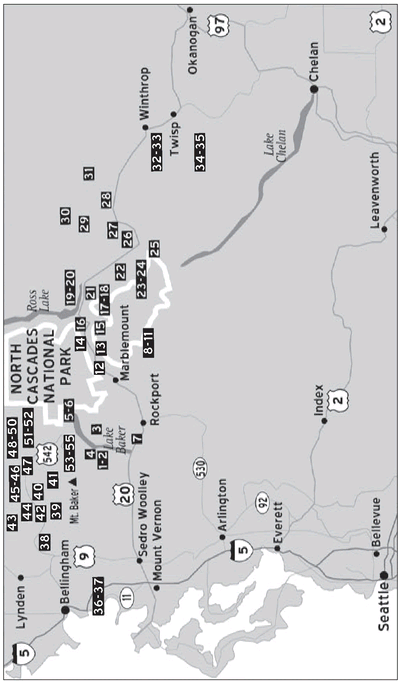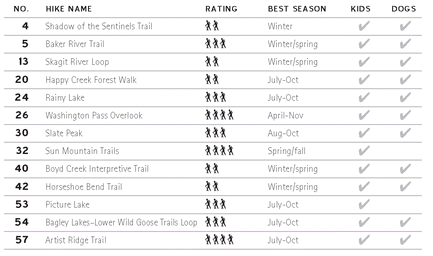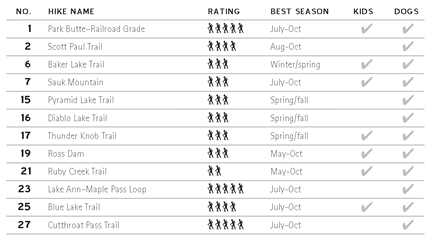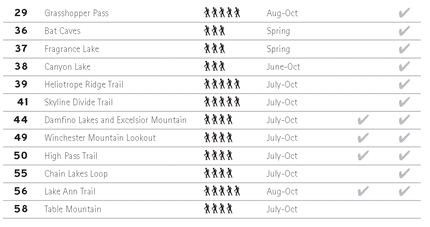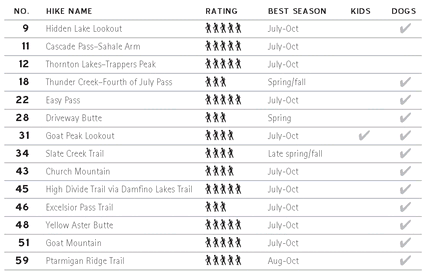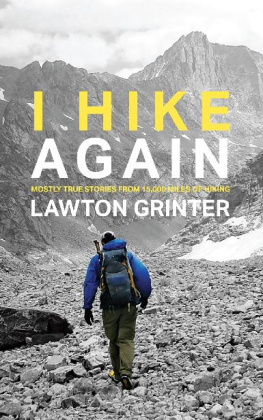Table of Contents
HIKES AT A GLANCE
Easy
Moderate
Moderately Difficult
Difficult
Extreme
ACKNOWLEDGMENTS
First, I want to thank my wife, Jennifer, and son, Baker, lifes two greatest hits as far as Im concerned. Their patience and support throughout have been invaluable. I also want to thank the following individuals and organizations for offering their support, expertise, and/or friendship: Doug McKeever, Tim Schultz, Frank Schultz, Fred and Maiken Nielsen (BIG thanks), the Steele family, the Brotherton family, Margaret Gerard, Heather Helgeson, Tim Manns at the National Park Service, Montrail, Ultimate Direction, and Smartwool. Finally, thanks to Seabury Blair Jr., Ron C. Judd, and everyone at Sasquatch Books.
This book is dedicated to my father, Paul McQuaide, to thank him for taking me outdoors and showing me where all the good stuff lay.
INTRODUCTION
When I was a kid growing up in the nice part of New Jersey, my dad would take my brother Chris and me for walks in the woods. Along with allowing us to take our slap fights and spit battles outside, these day trips were usually undertaken with the hopes of spotting some rare or unusual bird that someone my dad kinda knew thought that he mightve seen. Or heard. Usually, it was a pileated woodpecker or great-horned owl that had supposedly perched itself momentarily on a fence post in an abandoned field miles awayand that, of course, we never saw. Although I did see a blue jay once. And another time, Im pretty sure we saw a red-tailed hawk.
But I didnt care that we never ended up seeing what we set out for. It was just great kicking my way through the woods, rock-hopping across streams aided by my trusty, dad-customized walking stick, making for the summit of what seemed an Everest-like hillock, perhaps 200 feet high. From that great height would be revealed hill upon hill of broccoli headsthats what the deciduous trees looked likestretching on seemingly forever. Or about three miles. Maybe.
Those day hike mini-journeys sparked a lifelong love affair with the outdoors. Theyre the reason why, these days, my closet floor is inches-deep in dirt and dried mud from the Imelda Marcos-esque number of hiking and climbing boots and trail-running and approach shoes that I own.
The past fifteen years of this affair have been spent hiking and running the trails of the North Cascades, some of the most rugged and wildly scenic country in the Lower 48. Pileated woodpeckers and great horned owls are the norm here, not the exception. Other norms: glaciated peaks two miles high; ancient, megagi-hugic trees; slippery slimy slugs; rainbows of wildflower meadows; mountain lions; mosquitoes and bears (oh my!); and of course, panoramic mountain vistas where the views stretch for hundreds of miles across the state.
Day hiking is a truly great way to experience all of these norms. It offers less wear and tear on your body than backpackingyoure not carrying an enormous packand of course, by its very name, day hiking requires a much smaller time commitment. Its true that with day hiking you dont delve as deep into the wilderness as when backpacking. However, over the course a hiking season, day hiking allows for a multitude of shorter, still powerful mountain experiences as opposed to just one or two grand backpacking expeditions.
Hopefully, if youre not already, you will come away from this book as enamored of the outdoors as I am. If nothing else, youll have learned of some great places to take your slap- and spit-fights.
Mike McQuaide
PS: Yes, there is a nice part of New Jersey.
THE NORTH CASCADES
The Cascade Range stretches all the way from the Fraser River in lower British Columbia south to northern California. For the purposes of this book, however, the North Cascades will be defined as that section of the range from Highway 20/Cascade River Road north to the U.S.Canada border. Also included are a couple trails in the Chuckanuts, which some people define as the only place along the coast where the Cascades connect to the sea. Still others say theyre not technically part of the range, but then again, who cares? Theyre beautiful places with terrific trails offering stunning views to islands, mountains, forests, and Puget Sound.
There are two sides, literally, to the North Cascades. The west side puts on a bit of a wet face. Clouds rolling in from the ocean tend to dump most of their moisture on the west side of the Cascade crestelevation, about 5,000 feetbefore they ever make it to the east side. From November to April, this means snowso much snow, in fact, that during the 1998-99 snow season, a world record 1,140 inches of snowthats 95 feetfell at the Mount Baker ski area, about 40 miles east of Bellingham. The rest of the year those clouds offer much in the way of rain, showers, drizzle, mizzle, fog, and precip. Though from mid-July to the end of August, they do seem to give it a rest and theres no finer place in the world than the west side of the North Casades. Because of the heavy precip, youll not only run into more snow on the west side but also be more apt to tickle the toes of glaciers, which are more prevalent here than anyplace else in the Lower 48. Not surprisingly, waterfallsthats why theyre called the Cascades after alland, water in general, are more plentiful on the west side too.
With the clouds mostly rained and snowed out by the time they cross the crest, the east side enjoys less snow and rain than the west, thus more sunny days. In a typical year, mountain trails on the east side are clear of snow a little earlier in the year than those on the west.
Common trees in the North Cascades include western redcedar, western hemlock, Douglas fir, and Pacific silver fir, with the east side of the Cascades boasting ponderosa pine, Engelmann spruce, and subalpine and western larch. Several trails in this book offer walks among trees more than 500 years old.
Being a day hiking guide, this book wont even pretend to be a comprehensive guide to Northwest flora and fauna; critter-wise and plant-wise, the species are too numerous to describe. However, some of the common folk worth a mention include bald eagle, osprey, black bear, Roosevelt elk, mountain lion, hoary marmot, pika, mountain goats, American dipper, and ravens. Among the plants youre likely to see are trillium, Indian paintbrush, subalpine lupine, mountain heather, columbine, devils club, huckleberries, blueberries, and more fungis and algae than you can shake a hundred sticks at.

